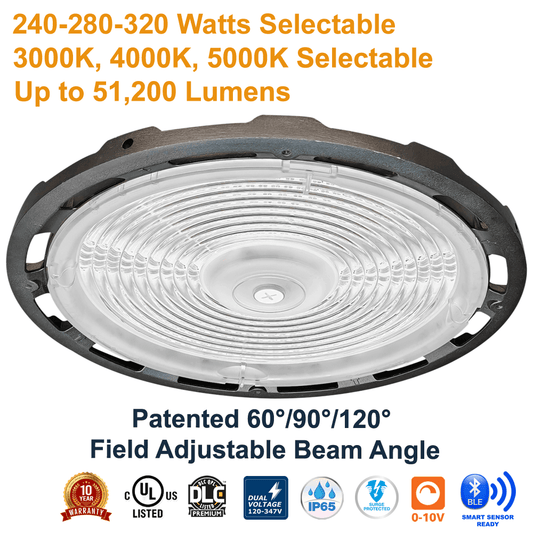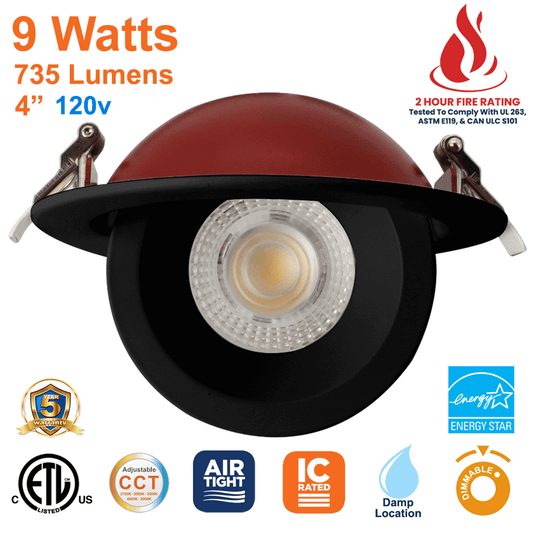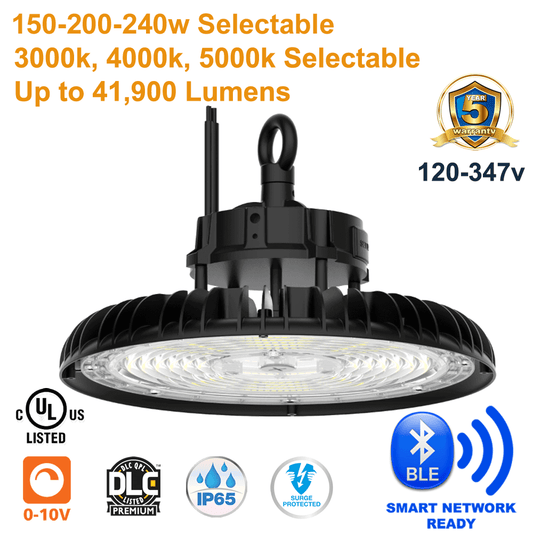IP Rating — the two-letter acronym you often see listed on the spec sheets of LED Commercial Lighting fixtures. But what d
oes it actually mean? It's a critical consideration when choosing the right lighting for your space, whether you're browsing LED High Bay lights or in the market for an LED Pot Light. This guide will unpack everything you need to know about IP ratings.
Understanding IP Ratings: The Basics
The term "IP rating" stands for "Ingress Protection" Rating. This system is designed to provide users with more detailed information about a product's protective qualities, particularly concerning dust and water. The International Electrotechnical Commission (IEC) assigns these ratings to clarify how well an enclosure can protect the equipment inside from environmental factors.
Each IP rating consists of two digits:
- The First Digit represents the level of protection against solid objects, including dust.
- The Second Digit signifies the protection level against liquids, primarily water.
This means when you're looking at LED Panel Lights for an indoor office space or LED Flood Lights for a parking lot, the IP rating will give you an idea of their resistance to dust and water.
The Importance of IP Ratings
IP ratings are critical when choosing the right lighting fixtures for specific environments. Understanding them helps in determining the suitability of a fixture for a given setting. It also aids in the selection of fixtures that can safely withstand the conditions of their intended environment.
In most cases, LED fixtures used outdoors need a higher IP rating to withstand various weather conditions, while indoor LED lighting doesn't require such high protection. In the case of LED lights, they carry a minimum IP Rating of IP20 but a fixture’s IP Rating will vary based on the specific model and the manufacturer's intentions for its use. If you're choosing between LED Area Lights for a building’s exterior or UFO High Bay LED Lights for a large retail space, the IP rating can play a role as a determining factor.
IP Ratings For LED Lights: The Breakdown
The first digit in the IP Rating indicates the level of protection against solids, such as dust and other small particles. The scale ranges from 0 (no protection) to 6 (complete protection against dust). Therefore, a rating of IP6X would suggest that the LED fixture is dust-tight.
The second digit refers to the protection level against liquids. This scale ranges from 0 (no protection) to 8 (protection against long periods of immersion under pressure). Hence, a light with an IPX8 rating can potentially be used in extremely wet conditions or underwater.
To illustrate, an LED fixture with an IP rating of IP65 would be dust-tight and have protection against low-pressure water jets from any direction. This makes IP65 safe for outdoor use and can withstand heavy rain. It is also a good choice for a damp indoor area such as an arena without an insulated ceiling.
When it comes to indoor lighting, fixtures with a minimum IP20 rating are usually suitable for general use, offering protection against objects larger than 12.5mm and no protection against liquids. Meanwhile, for outdoor LED lights, an IP65 rating is typically the minimum requirement in open spaces. This ensures that the light is dust-tight and can withstand jets of water, making it suitable for exterior settings.
For more specific environments like bathrooms, the IP ratings required can vary. Bathroom ceiling lights, for example, should have an IP rating of at least IP44. This means they are protected against objects larger than 1mm and splashing water.
On the other hand, shower lights need to be more water-resistant, with a recommended IP rating of IP65 to protect against low-pressure water jets from any direction. And if you are searching for Vapour Proof Lights, they need to have an IP Rating of at least IP67, meaning they are dust-tight and can withstand immersion in water up to 1m in depth.
In the next part of this guide, we'll explore the difference between IP and NEMA Ratings, wet-rated vs. damp-rated LED lights, and how to choose the best IP Rating for your specific lighting needs.
Exploring More about IP Ratings and Their Importance for LED Fixtures
Having provided a basic understanding of IP Ratings in the previous part, it's now time to further explore how IP Ratings are determined, the different IP Rating requirements, and how they compare with NEMA Ratings.
How Are IP Ratings Determined for LED Lights?
IP ratings are determined through a series of tests that LED lights are subjected to, which measure their resistance against the intrusion of solids and liquids. The tests follow stringent guidelines defined by the International Electrotechnical Commission (IEC). The results of these tests then form the two-digit IP rating that you often find on LED fixtures.
To perform the tests, the lights are exposed to various materials and conditions. For instance, dust tests involve subjecting the LED light to a dust-filled environment, while the water resistance tests can involve anything from splashes to high-pressure water jets or prolonged immersion.
These testing processes ensure that each LED light product, be it an LED Warehouse Light or an LED Down Light, meets the standards of the IP Rating it claims.
How to Choose the Right IP Rating for Your LED Lights
Choosing the right IP Rating for your LED fixtures largely depends on the environment where the lights will be installed. The minimum IP rating required for general indoor use is typically IP20, which offers some protection against larger objects and no liquid protection.
However, for environments with high humidity or chances of water exposure, such as bathrooms or shower rooms, the lights need a higher IP rating. In fact, bathroom ceiling lights should ideally have an IP44 rating, whereas shower lights should have an IP65 rating for effective protection against water jets.
Outdoor LED lights require even higher IP ratings. The minimum requirement is usually IP65, which ensures the fixture is dust-tight and can withstand jets of water, a typical scenario during heavy rain.
It's worth noting that IP ratings do not directly reflect a light fixture's quality but rather its suitability for different environments. For example, a fixture from the LED High Bay collection might have a lower IP rating than a fixture from the LED Flood Light collection, but that doesn't mean it's an inferior product—it just indicates that it's suited for a different kind of environment.
IP Ratings vs NEMA Ratings: What's the Difference?
While IP Ratings are widely recognized globally, NEMA (National Electrical Manufacturers Association) Ratings are more commonly used in North America. Both are standards used to specify the environmental protection of enclosures around electronic equipment, including Commercial LED Lighting..
While IP ratings focus solely on protection against solids (like dust) and liquids (like water), NEMA ratings cover these aspects and additional factors like corrosion and construction practices. Thus, NEMA ratings provide a more comprehensive set of protection standards.
However, the two are not directly equivalent—while a high IP Rating might suggest a high NEMA Rating, a comprehensive review of the NEMA standards is necessary for a proper comparison.
In the final part of this guide, we'll look at how different LED lighting, from LED Pot Lights to LED Corn Bulbs, fare in terms of their IP Ratings, and what it means for their use in your commercial or industrial spaces. We'll also discuss how IP Ratings align with the concepts of wet-rated and damp-rated lights, providing you with a holistic understanding of how to choose your LED lighting wisely.
IP Ratings and Their Practical Applications in LED Commercial Lighting
In this final section of our guide, we'll take a closer look at how IP Ratings apply to various LED fixtures and the practical implications of these ratings for your commercial or industrial lighting needs.
IP Ratings in Different LED Lights
Different LED lights are designed to meet specific needs, and thus, they come with varying IP Ratings. For example, LED Pot Lights, commonly used for indoor applications, can come with IP20 ratings or higher. LED High Bay Lights, often installed in warehouses or factories where they are exposed to dust but not water, usually have an IP rating of IP40 and above.
Outdoor lights, such as LED Flood Lights and LED Area Lights, typically boast higher IP Ratings due to their exposure to external elements. An IP65 or IP66 rating is common for these fixtures, making them fully dustproof and protected against powerful water jets.
Moreover, for damp environments, you may consider LED Corn Bulbs with a high IP Rating. They are well-suited for such conditions and offer durable, efficient lighting solutions.
Wet, Damp, and Dry Ratings for LED Lights
While IP Ratings provide a solid understanding of the protection levels of LED fixtures, there are other ratings that you may come across, such as "wet", "damp", and "dry" ratings. They are particularly used when considering lights for locations with varying moisture levels.
A wet-rated LED light is designed to withstand direct contact with water and typically has an IP rating of IP65 or above. Damp-rated lights, on the other hand, are not designed to handle direct water contact, but they can tolerate moisture or indirect contact with water. These lights typically have an IP rating of IP54, at the most. Dry-rated lights are intended for areas with no exposure to water or moisture and can have IP ratings as low as IP20. To better understand how these ratings apply to pot lights, check out our comprehensive guide on choosing between wet-rated and damp-rated LED Pot Lights.
Selecting Lights with the Appropriate IP Rating
Choosing the right LED fixtures with appropriate IP Ratings for a commercial or industrial space is crucial. It not only ensures the durability of your LED Light Fixtures but also the safety of your premises. Be it an indoor office space or an outdoor industrial site; the right IP-Rated LED light can make a significant difference in your lighting efficiency and overall operational costs.
In conclusion, understanding IP Ratings is vital when selecting an LED fixture. While it may seem complicated at first, once you grasp the basics, you will be well-equipped to make informed decisions that enhance the lighting quality of your commercial or industrial space.
For further reading and detailed guides on different LED lights, explore our LED Network Blog. You'll find a wealth of resources, from understanding the basics of LED lighting to choosing the best fixtures for your specific needs.



























